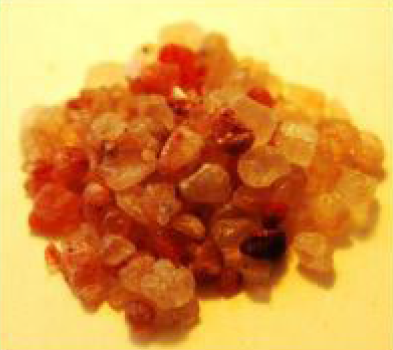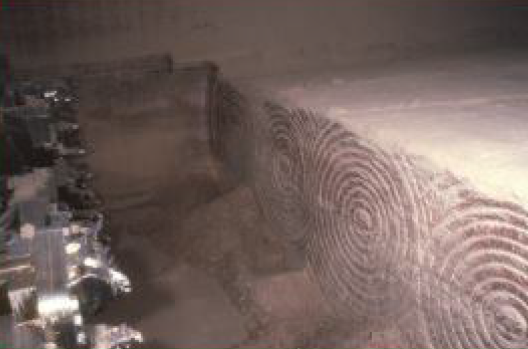⇦ Back to Fertilizer Lime Amendment Technology and Use Home
¶ Introduction
Langbeinite is a potassium-magnesium sulfate mineral used as a potassium fertilizer material. It is marketed as a potash fertilizer typically referred to by trade names like “Sul-Po-Mag™“, “K-Mag™”, or “sulfate of potash-magnesia".
¶ Production
Langbeinite is a distinctive geological material found in only a few locations in the world. Commercial supplies of langbeinite come from underground mines near Carlsbad, New Mexico, which were first commercially developed in the 1930s. These deposits were formed millions of years ago when a variety of salts, including langbeinite, were left behind after the evaporation of ancient ocean beds. These salt deposits were buried deep beneath hundreds of meters of sediment.
Langbeinite deposits are currently mined with large boring machines, washed to remove impurities, and then crushed to various particle sizes. Traces of iron oxide impurities give some langbeinite particles a reddish tint.
¶ Table 1. |
|
| Property | K2SO4•2MgSO4 |
| Fertilizer analysis | 21% - 22% K2O |
| 10% - 11% Mg | |
| 21% - 22% sulfur | |
| Density, pounds per cubic foot | 88 - 95 |
| Water solubility @ 68°F | 240 g/L |
| Solution pH | ≈ 7 |
¶ Agricultural Use
Langbeinite is a popular fertilizer, especially where several nutrients are needed to provide adequate plant nutrition. It has an advantage of having potassium, magnesium, and sulfur, all contained within a single particle, which helps provide a uniform distribution of nutrients when it is spread in the field.
This fertilizer is totally water soluble, but is slower to dissolve than some other common potassium fertilizers because the particles are denser than other potassium sources. Therefore, it is not suitable for dissolving and application through irrigation systems unless finely ground. It has a neutral pH, and does not contribute to soil acidity or alkalinity. This differs from other common sources of magnesium (such as dolomite) which will increase soil pH and from elemental sulfur or ammonium sulfate which will lower the soil pH.
Potassium-magnesium sulfate is frequently used in situations where a chloride-free fertilizer is desirable, such as with crops sensitive to chloride (including some vegetables and certain tree crops). Langbeinite is a nutrient-dense fertilizer with a relatively low overall salt index. Particular sources of langbeinite have been certified for use in organic crop production.
¶ Figure 1. Form of Potassium-Magnesium Sulfate

¶ Figure 2. Underground Mining Operations

¶ Management Practices
Langbeinite products used for dry bulk blending may have a wide range in particle sizes, which can cause uneven application patterns. A particular particle size should be matched with the specific need.
It often costs less than potassium chloride, but requires higher application rates to meet crop potassium requirements. Application rates may instead be based on the need for magnesium and/or sulfur. It is also sold as a prilled, granular product with 20% K2O, 20% sulfur, and 16% MgO.
Langbeinite has no restrictions for environmental or nutritional use when used at typical agronomic rates.
¶ Non-crop Use
There are no major industrial applications for langbeinite outside of agriculture
One form of langbeinite is sold as a feed-grade dietary source of potassium, magnesium, and sulfur for animals and poultry. All three of these nutrients are required for animal nutrition and each has a specific metabolic role required for optimal animal health. This feed material is “recognized as safe” by government agencies.
¶ References
IPNI. Nutrient Source Specifics No. 6: Potassium Magnesium Sulfate: Langbeinite. International Plant Nutrition Institute, Norcross Georgia. 1 pg.